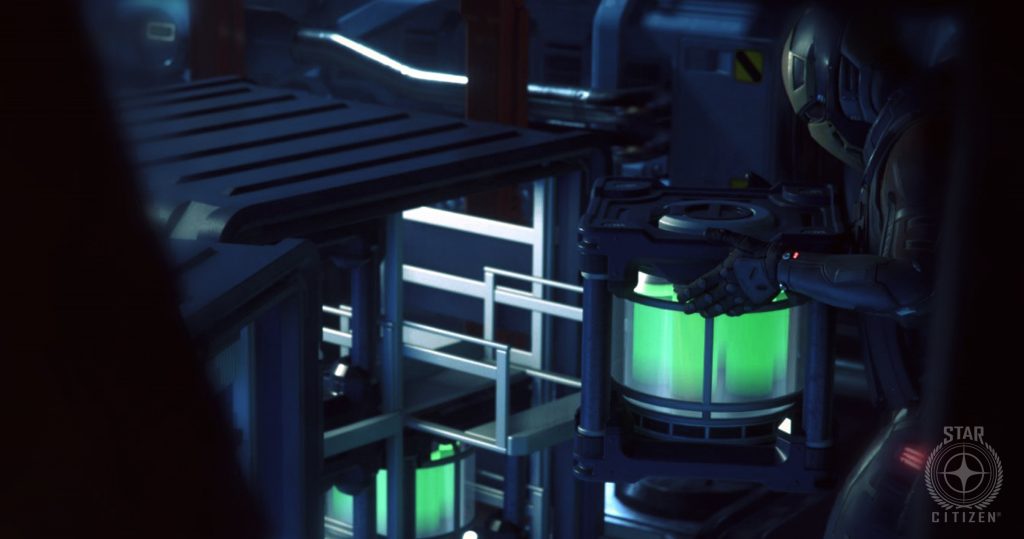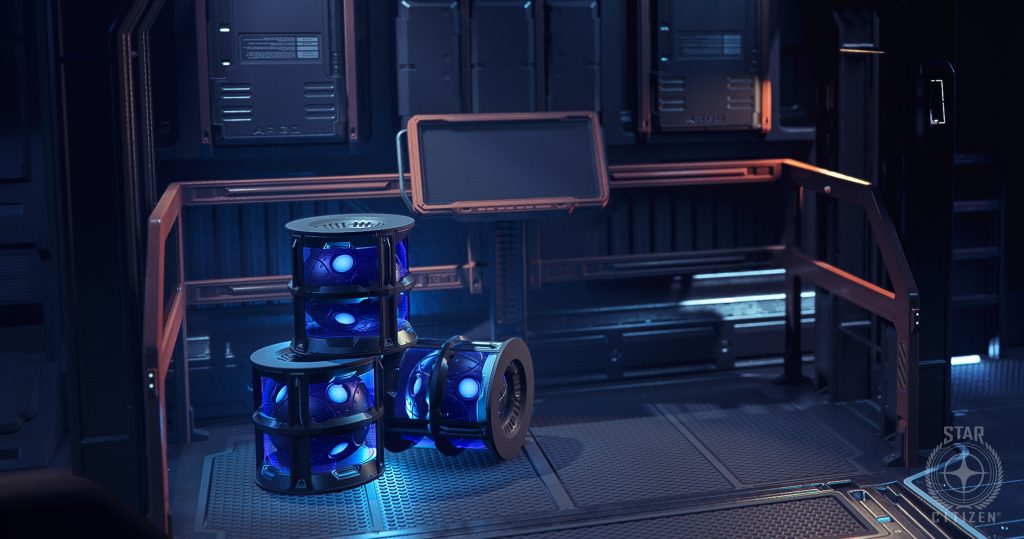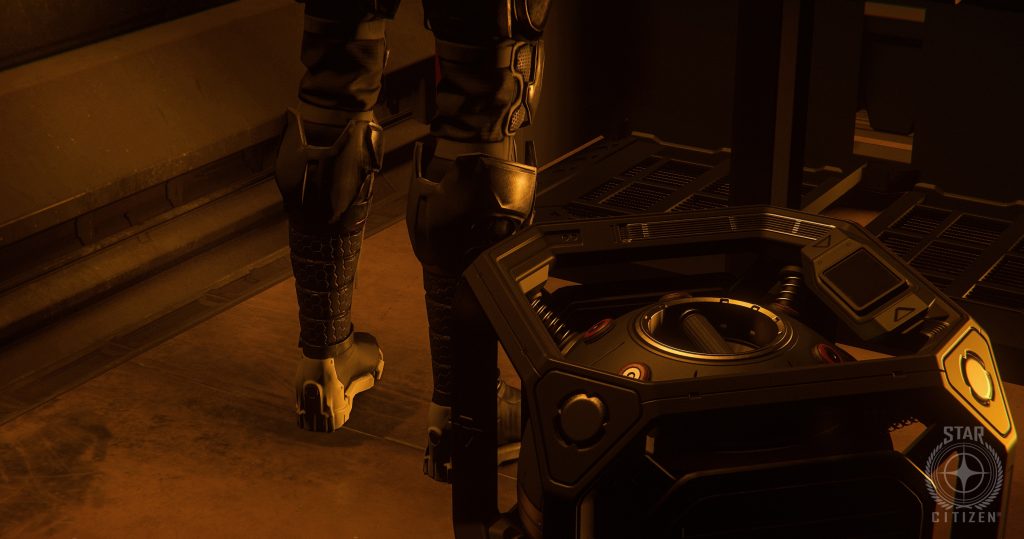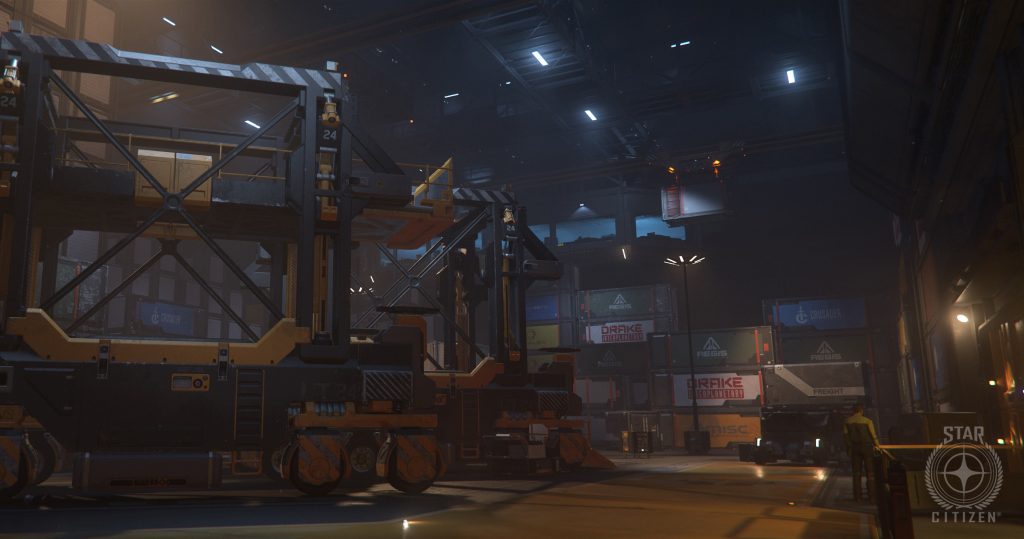Star Citizen Monthly Report New Cargo & Reputation
Welcome to a Star Citizen Monthly Report looking at what CI have been working on over the last few weeks in regards to the Persistent Universe and Star Citizen’s Core Systems and some details of what they are currently working on now in September.
A lot of work is focused towards Alpha 3.11 and associated features as well as expanding gameplay beyond that – They looked into the cargo hauling profession. Work is being done to see it in a much broader sense, with aspirations to expand the system to make it more interactive and exhilarating.

The Gameplay Features Team said : “Cargo haulers will ultimately need to monitor their cargo, checking to make sure it’s stable and in good condition while they travel. Beginner haulers will need to check things like temperature while hauling food, whereas experienced haulers may need to check the stability of volatile shipments. We feel the new design will be a great update for the profession and look forward to seeing the reactions from citizens when it comes online!”
A set of new volatile cargo assets was kicked off too. Each of the three types requires unique visuals to reinforce their gameplay along with cargo cage assets to help bed them into their surroundings. Props also supported the new push/pull feature work being developed by the Actor Feature Team, which involved the conversion and technical setup of some existing trolley props.

They are also working on a new reputation system soon we will have a reputation score that is tracked as missions or tasks are performed. The system will allow players to earn perks through reputation gains and will tie into player perks. It will also add support for NPC organizations and their rankings (previously referred to as guilds). Reputation won’t roll back when they push a new build and wipe the databases… in the same way assets are carried over to major patches where possible.
They worked on some new missions & journal entries for 3.11 as well as plans for expanded mission content for future releases.
Most ‘visual’ teams have embedded UI artists, all of who have been working on a variety of upcoming features. For the Actor Feature Team, the artists polished the Personal Inner Though system and external inventory, both of which will be used in the PU and SQ42. New concepts for holo-tech were devised for the Vehicle Feature Team, while adverts and branding for the cargo deck were created for the Environment Team.

The UI Team has also created new designs for the reworked & improved starmap. While it shouldn’t be expected any time soon, it’s a piece of core functionality that is regularly used.
Ships
They are completing the Final art stage of the Crusader Mercury, with some areas heading into the flight-ready phase, including damage geometry. Additional detail is being applied to the interior rooms and a functional dashboard. This will include independent power control for various systems, weapon controls, and more. Each system is planned to have built-in feedback to allow players to see the state of each system at a glance and identify if damage is preventing a system from working.
The Crusader Hercules also continues to be built out, with focus on the habitation areas, taking them to the final art stage. The lift and the cargo hold also made progress, and the corridor connecting to the bridge was completed, including suit lockers, escape pods, and several component bays.
The Origin 100i series is now art-complete and has been handed off to downstream teams, while the recently unveiled Esperia Talon is in the final art stage and receiving a detail pass.
Vehicles features have been working on showing which hangar a player’s ship is in after it’s spawned from an ASOP terminal. For a future release, they’re working on a feature to highlight a ship’s available entrances too, such as ladders, doors, and elevators.
Work on docking continues. Various aspects of the UI were iterated on to adequately detail docking progress and to give suitable guidance to a docking port regardless of its type or orientation. Different IFCS control modes are also being investigated to let players control the ship relative to a port to make docking easier.
They also worked on the headless client automated testing system that enables restricted area landing splines to be tested automatically as part of the flow. Hopefully this will see a major improvement to that feature in the near future.
Capital ship improvements have been made, specifically the way gradual damage reads across the hull. Fire too had improvements syncing between server and client.
Further concepts were created for shields, including the visual read of impacts to show players the health of the shield, and improvements were made to quantum travel VFX.
Environment
Pyro VI is now at the ‘whitebox complete’ stage. They’re currently placing ground textures, objects, and scattering logic using the paintbrush system. Once the brushes/biomes are finalized, a final painting pass will be done to ensure meaningful distribution of assets.
Pyro V’s moons also entered into production. The Environment Art Team said “This is great timing for the team, as it lets all the artists grab one moon and go crazy with the new tools. They have a clear idea of how to use the new tech, but this is also a good opportunity to see how the artists go about making a new planet from scratch and use slightly different workflows.”
One of the hopes for this tech is that, along with better visuals, new planets will be created much more quickly than previously possible.
Stanton’s planets and moons are currently being updated with the latest tech too.
Progress was also made on Crusader, with R&D underway into flow maps to bring the gas giant to life.
R&D into volumetric clouds continued and detailed plans for experiments and next steps were drafted.
Work on the organic shader continued too, bringing tighter integration with the planets to enable the artists to use assets in a variety of biomes and have them automatically integrate into their surroundings.
Lighting added the final touches to the Cargo Deck Facilities & exterior add-on modules as well as ensuring they integrated with stations visually.
Work continued on the cargo deck props, with consoles and material work completed for various heavy machinery. A pass was completed on the larger cargo containers, adding more branding and creating a less-demanding background dressing set for the Environment Team.
The Lighting Team also began preliminary work on Orison.
R&D work is still ongoing to improve NPC and character lighting in comms calls. New tech is being developed to spawn a dynamic lighting rig onto a character, which takes into account the surrounding environment lighting and re-projects it directly onto the character’s face. This has the potential for some more cinematic lighting opportunities.
VFX Team progressed with the refinery location effects, including improvements to the molten metal pouring from large containers in the background, which were in pre-production last month.

Items & Animation
Greybox work continued on automatic defense turrets and they looked into missile and missile-rack metrics, ensuring the props work with all missile variants.
The Behring BR2 Shotgun is nearly complete. The GP-33 grenade launcher received an additional pass to adjust some of the rig and ammunition setup too.
Animation have been working on object and grenade throwing, knockdowns and knockbacks, and several new weapons. They also further developed AI interaction with seats in capital ships, the bartender, ship inspections, and progressed with their work on NPC ammo retrieval. They also continued creating female player faces and emotes.
The Behring mk4 frag grenade was updated to support the new throw feature and gained a visual indicator to show the ‘cooking’ time before it’s thrown.
Various new items and armors are being worked on as well as some new assets for 3.11 assumedly for the new throwing system.
AI
Social AI have been focused on looking at bartender functionality in multiple other vendors.
This allows them to quickly populate the world with an initial version of interactive characters capable of selling different types of goods.
Work on realistic firing continued for FPS AI, including the implementation of physical ammo boxes and ammo refill behaviors. They also added functionality to swap weapons so NPCs no longer need to execute the unequip/equip flow to transition from one to another. This also empowers the animators to create smooth transitions when swapping weapons.
Beyond this they are planning behaviors for more realistic FPS combat such as how character skills and traits influence combat behaviors and how emergent synergy between characters can create a more realistic and flowing combat experience.
Ship AI have been working out an Accuracy System based on the skill of the AI character in question. The skill determines how rapidly the gunner’s aim moves to a location where a hit is more likely. Aiming error is a dynamic variable that changes depending on how fast the target moves relative to the shooter. For example, if a player is almost stationary, the AI will shoot more consistently, forcing players to perform defensive maneuvers. This system applies to all AI, including all varieties of turrets and FPS combat. Furthermore, ship and turret AI can now use charged weapons correctly providing their fire actions permit it, such as the Idris’ rail gun.
Backend & Server
Significant effort was invested in building a new backend architecture to facilitate high player concurrency on game servers.
Changes and fixes were made to the wallet service as it was running ‘hot’ under load, with the entitlement processor updated to support the upcoming super cache. Most of the code for the super cache is finalized, though some reliability and optimization work remains before it can be tested and tuned. The meshed loadout service also went through load testing and is expected to be completed on schedule.
A lot of low-level networking code work was finalized, including network system startup and shutdown, and primary work on the meshed variable service began. This includes the use of direct connections rather than global routing through the diffusion router, which is currently in the test and tuning phase – Note there is no p2p communication there.
Engineering / Engine
Work on the Gen12 render continues as they convert all the old code and systems over to the new.
Cleanup in the shader system and renderer for thread safety continued, as did G12 brush rendering. They also started to look into DX11.1 API support (Windows 8.1 and up) for binding CBs using offsets for intermediate performance improvements until Vulkan ships.
They have added support for SDFs for physics grids and various other integrations as well as
g-force calculation for all actor entities.
They’ve made some optimizations to multi-threading.
They have a new API crash handler for better debugging.
They are working on memory usage bugs, leaks and optimization too.
Work on the Vulkan backend made good progress too
There was a persistence issue which was resolved that resulted in 93,000 ships being returned to players accounts!
And that’s it for this monthly report… tho we will be taking a look at the Squadron 42 Report Shortly